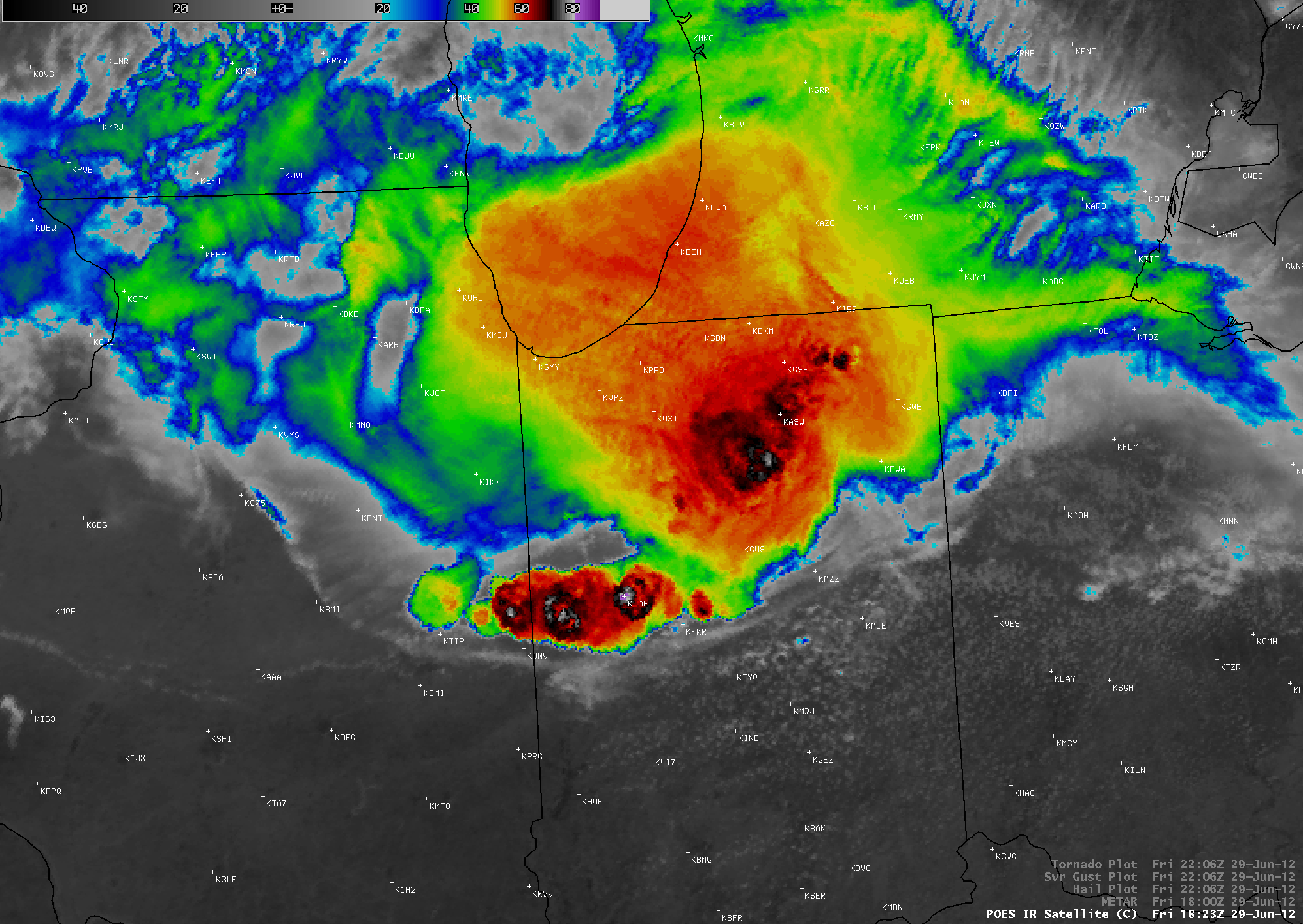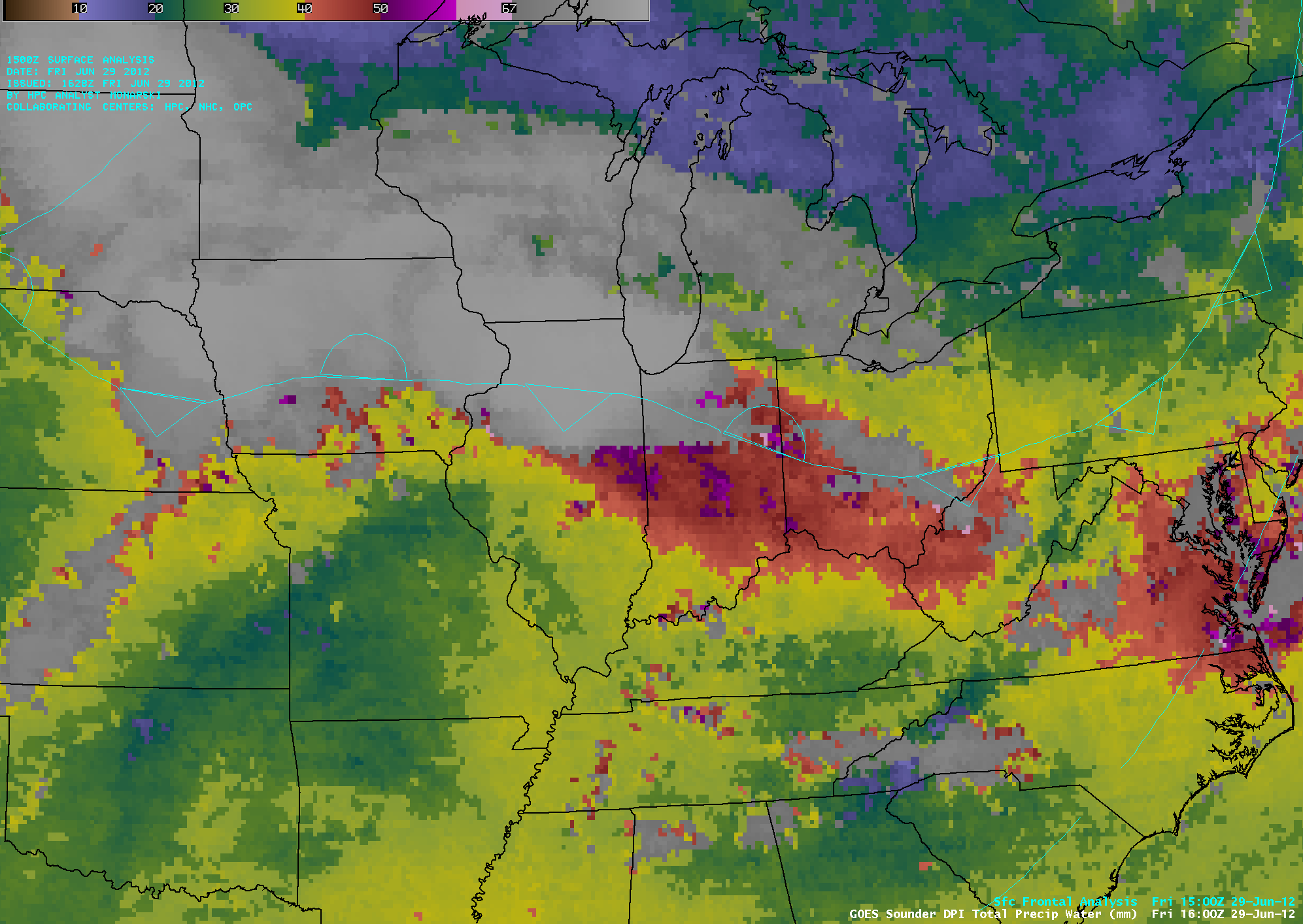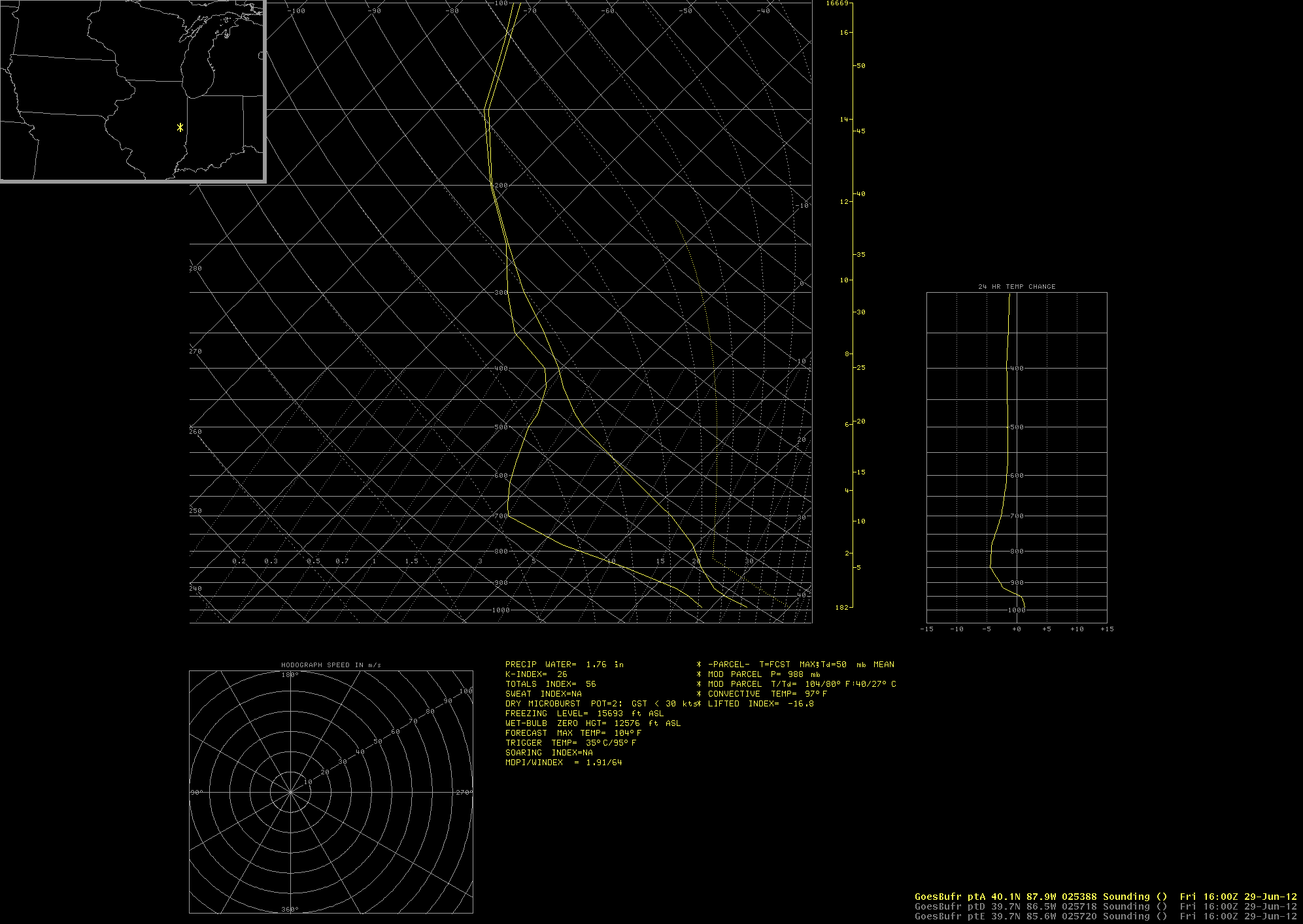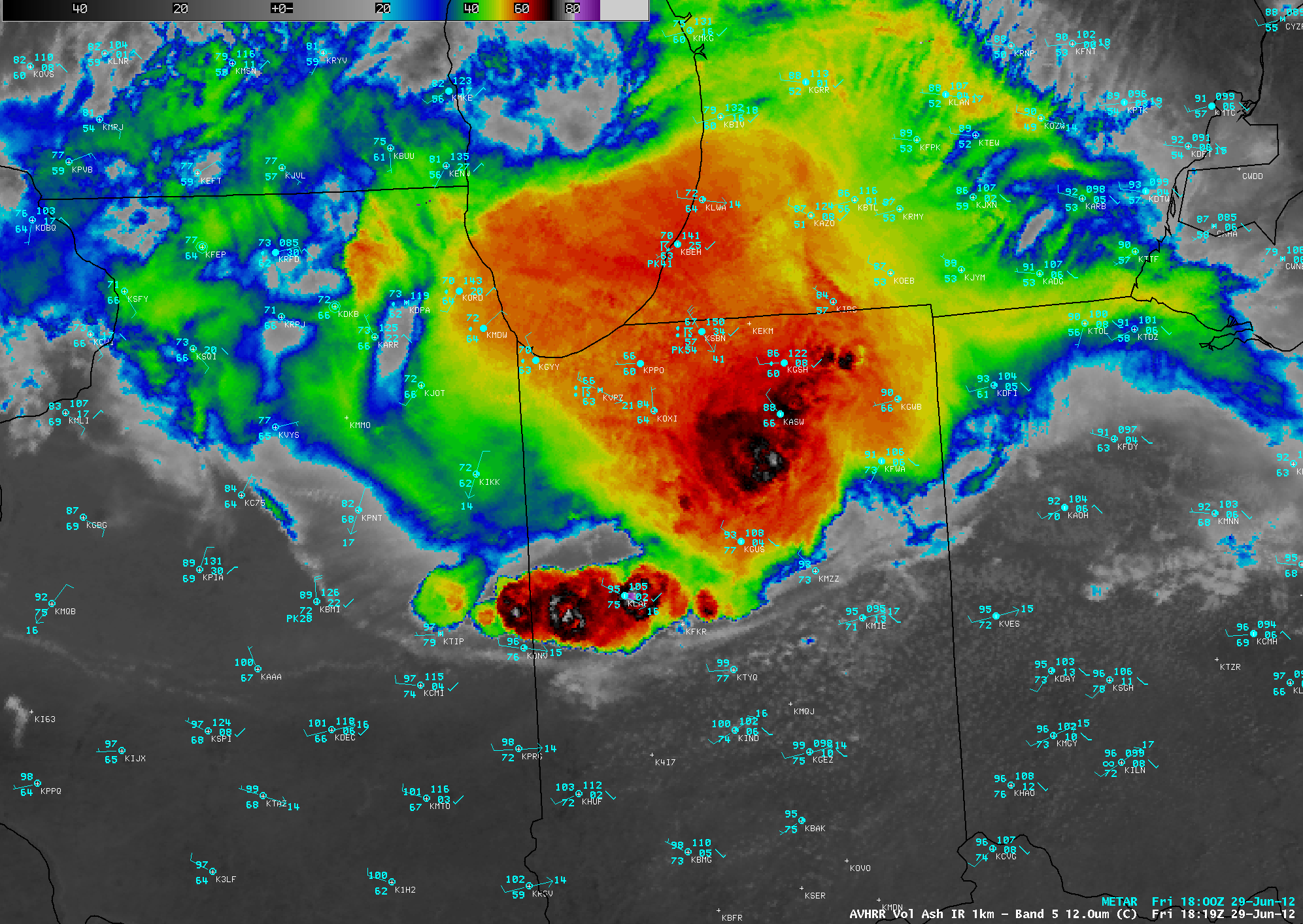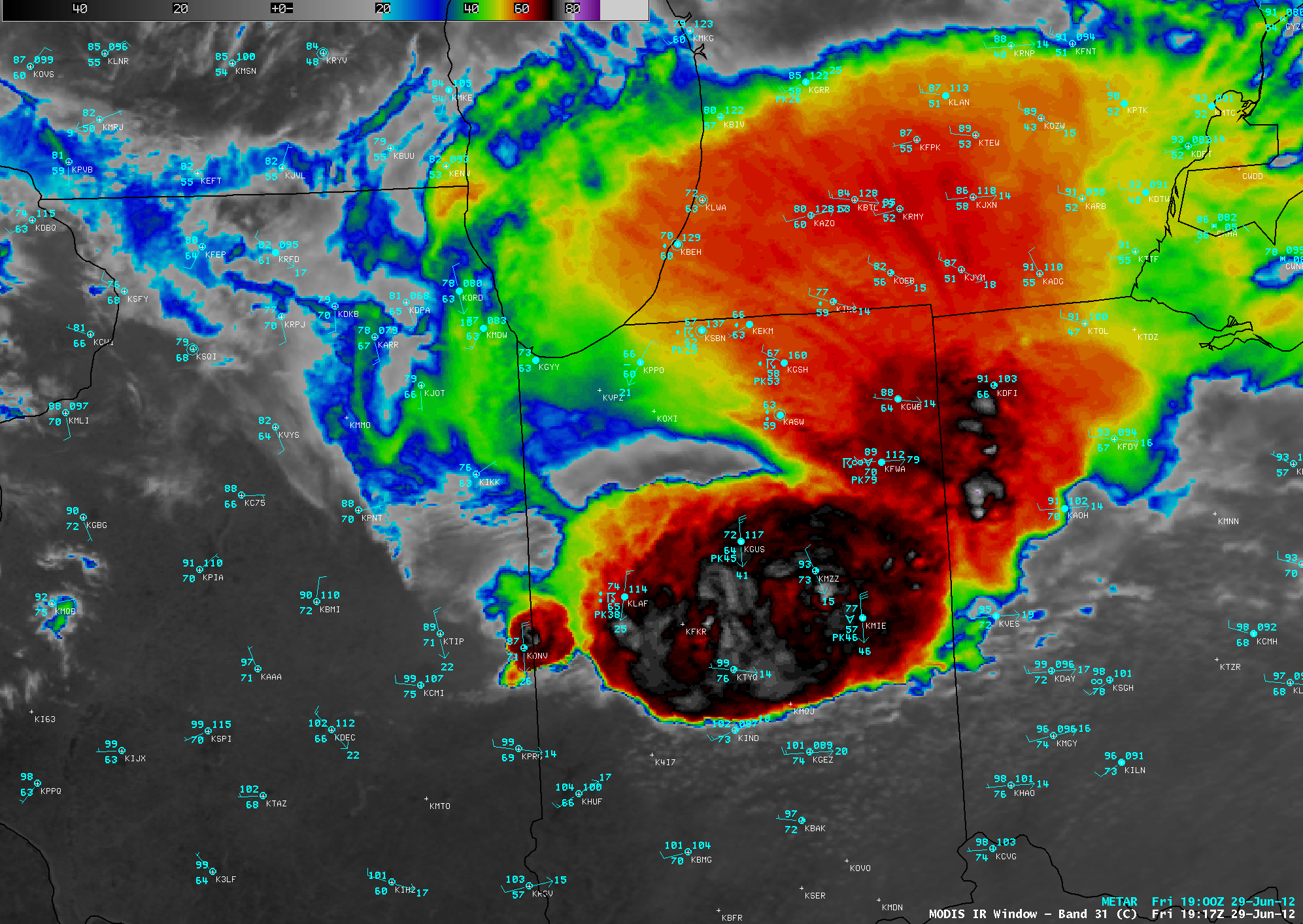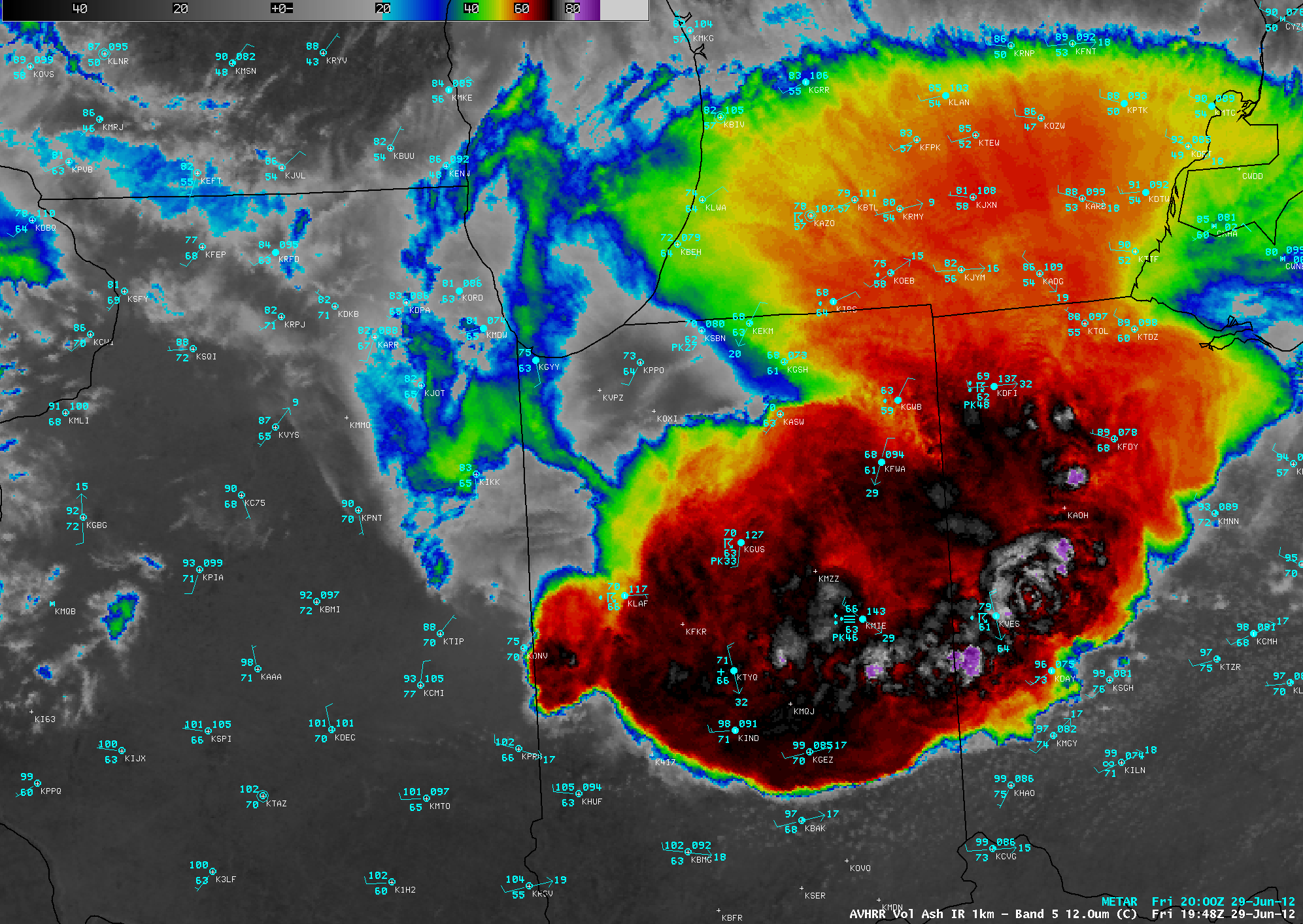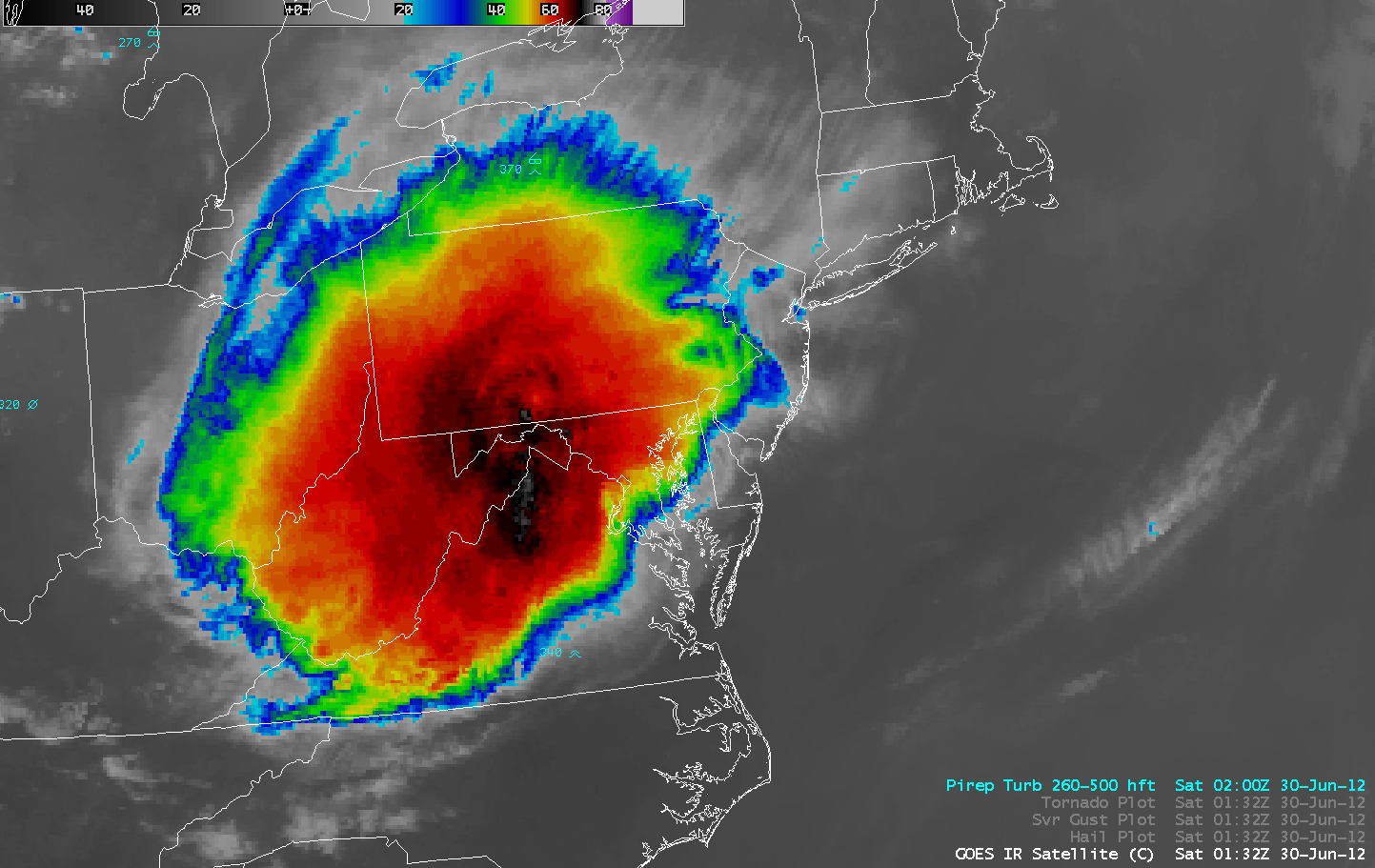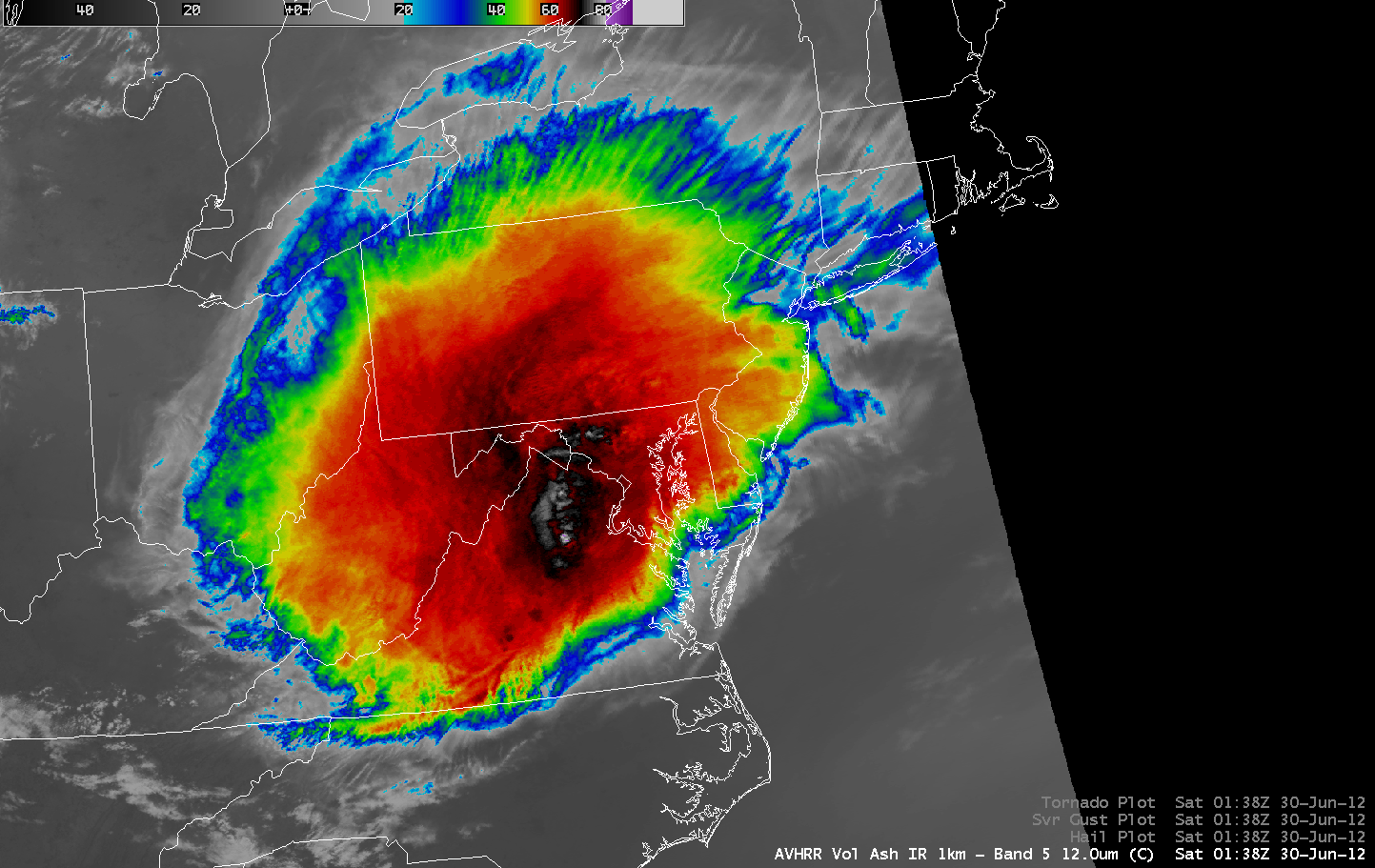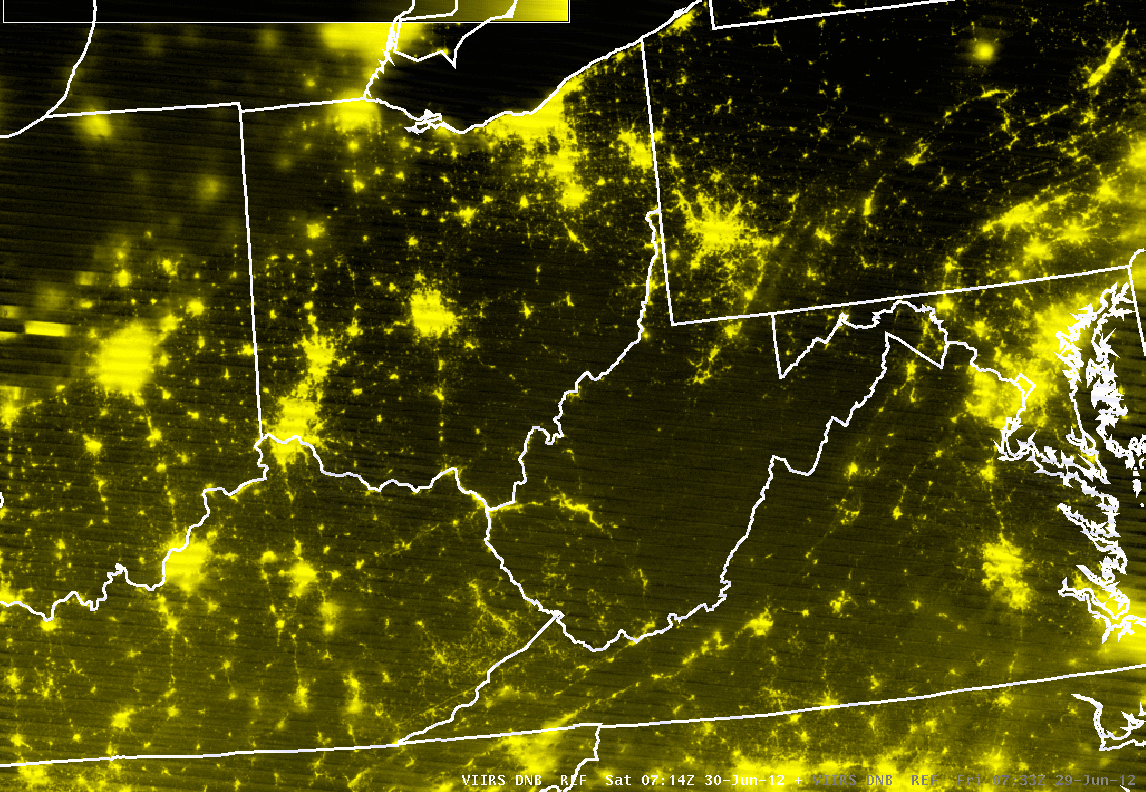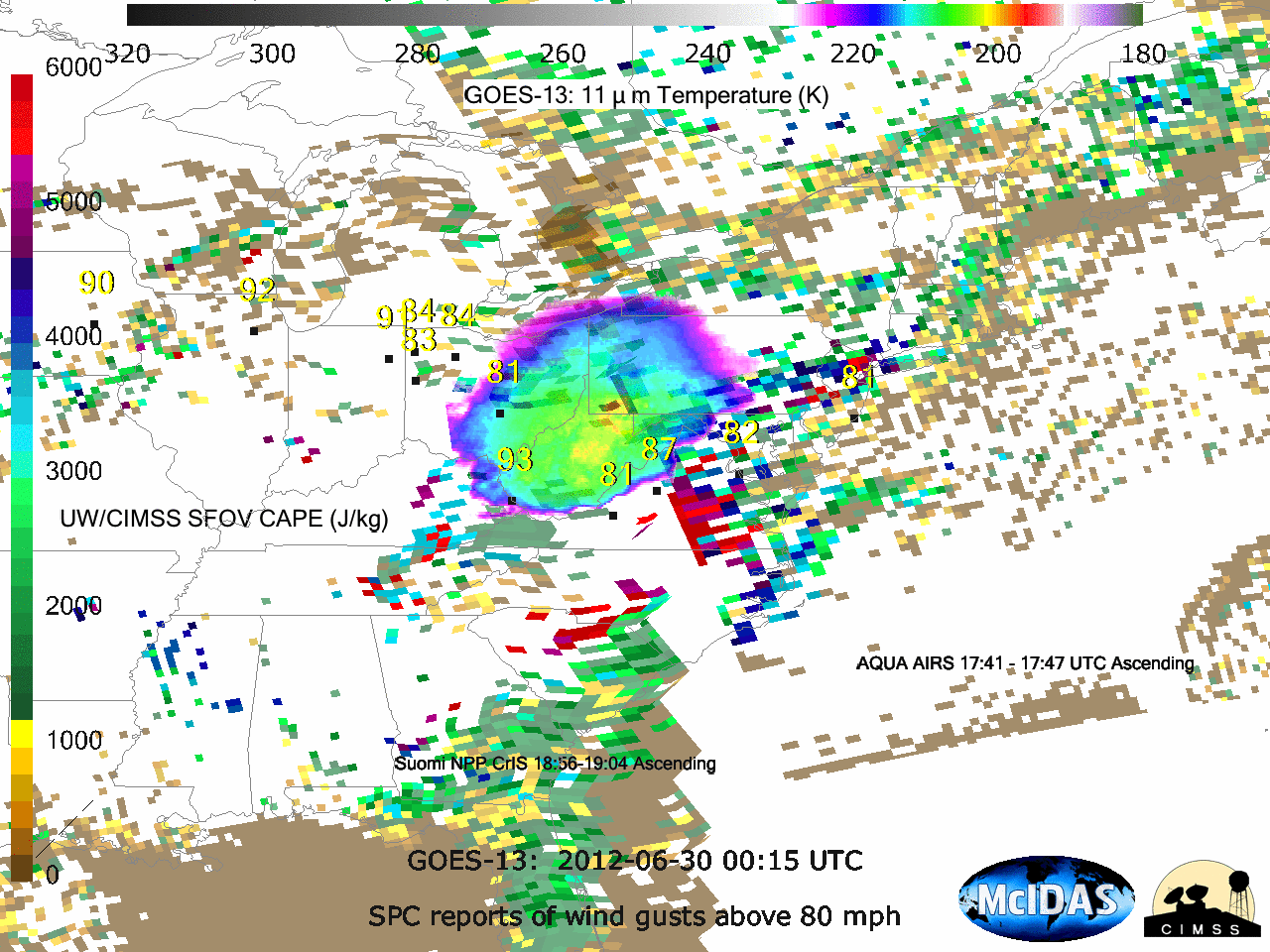Derecho moving southeastward from the Midwest to the East Coast
An AWIPS image of 1-km resolution POES AVHRR 10.8 µm IR channel data with overlays of cumulative SPC storm reports (above) showed a strong mesoscale convective system (MCS) as it was moving southeastward across northern Indiana at 18:23 UTC or 12:23 PM local time on 29 June 2012 — this MCS evolved into a long-lived progressive derecho event, producing a broad swath of wind damage across the Ohio River Valley and into the Mid-Atlantic states (SPC storm reports). A peak wind gust of 91 mph was recorded at Fort Wayne, Indiana, with hail as large as 3.0 inches in diameter falling near Danville, Illinois. At least 12 fatalities have been attributed to this derecho.
Two ingredients helping to fuel the development and upscale growth of this derecho event were convergence/lift along a quasi-stationary frontal boundary, and rich moisture pooled along and just south of the frontal boundary. 10-km resolution GOES-13 sounder Total Precipitable Water (TPW) derived product imagery (below; click image to play animation) showed TPW values in the 50 to 65 mm (2.0 to 2.4 inch) range.
================================
There was also extreme instability present along and just south of this frontal boundary, as seen on GOES-13 sounder derived product images of Lifted Index or LI (above; click image to play animation) and Convective Available Potential Energy or CAPE (below; click image to play animation). AWIPS cursor sampling of these instability products showed widespread LI values of -14.8º C, and CAPE values of 6000 J per kg (denoted by the lighter purple color enhancements on each sounder product).
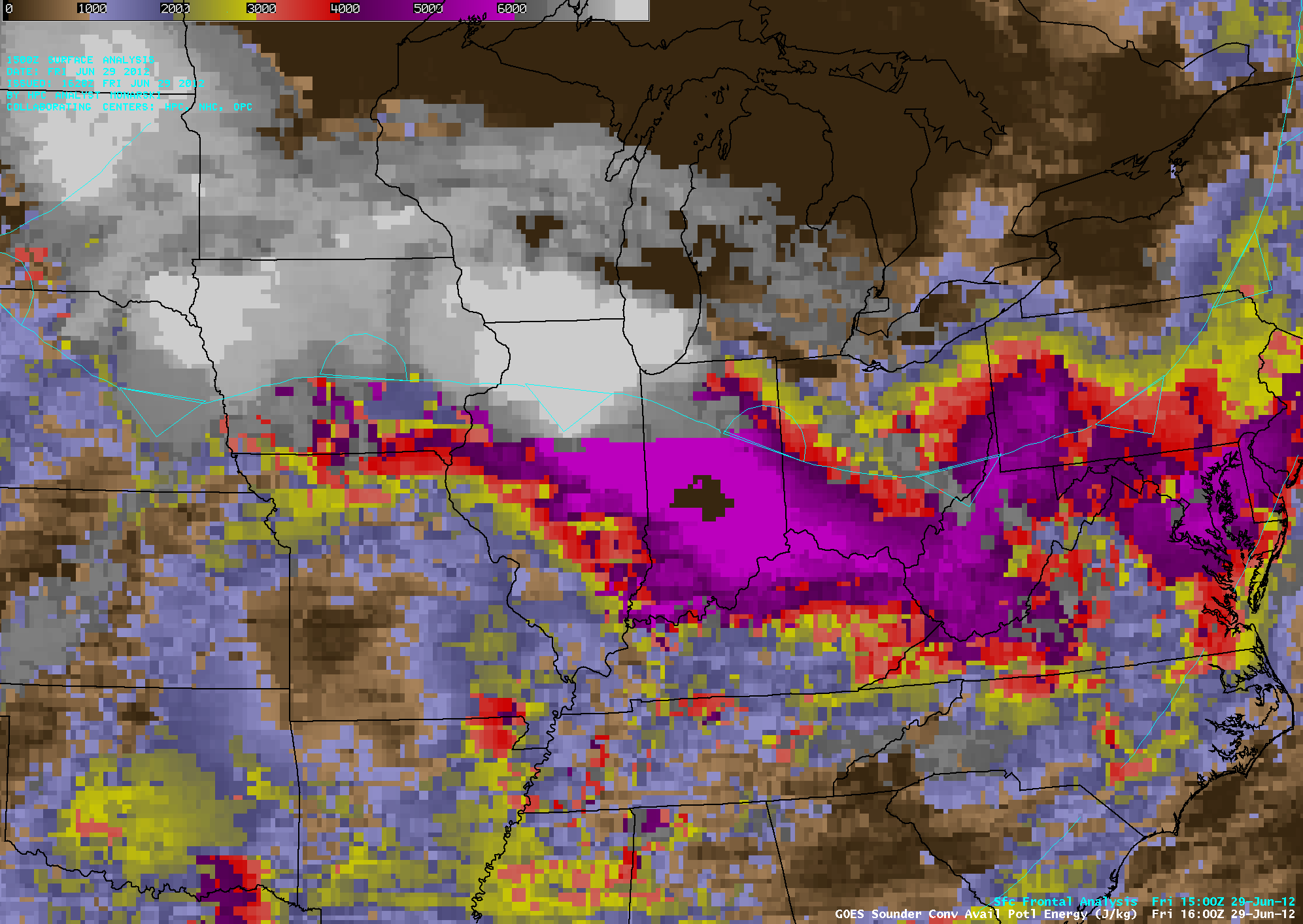
GOES-13 sounder Convective Available Potential Energy (CAPE) derived product (click image to play animation)
Clear sky single-field-of-view (SFOV) GOES-13 sounder temperature and moisture profiles within this axis of extreme instability (below) showed an LI value of -16.8º C at Point A in far eastern Illinois at 16 UTC. Note that the locations of some of these available GOES sounder temperature/moisture profiles were situated between the standard rawinsonde sites of Lincoln, Illinois (KILX) and Wilmington, Ohio (KILN) — this demonstrates the potential value of using GOES sounder data in regions (or at times of the day) between conventional rawinsonde launches.
3 comparisons of 1-km resolution POES AVHRR and MODIS visible channel and IR channel imagery with plots of cloud-to-ground lightning strikes (below) depicted the storm structure at 18:18 UTC, 19:17 UTC, and 19:48 UTC. Thunderstorms on the 19:48 UTC POES AVHRR image exhibited a minimum cloud top IR brightness temperature of -90 C.
4-km resolution GOES-13 10.7 µm IR channel images with overlays of SPC storm reports (below) showed the southeastward progression of the MCS and the attendant hail and damaging winds reports. The GOES-13 IR images also exhibited unusually cold IR brightness temperatures, at times as low as -81º C (at 20:45 UTC).
During the following overnight hours, the core of the derecho continued to move southeastward across West Virginia, Virginia, and eventually to the East Coast and the adjacent offshore waters of the Atlantic Ocean. In addition to creating a widespread swath of damaging winds at the surface, the MCS was also responsible for a number of reports of high-altitude turbulence, as seen on 4-km resolution GOES-13 10.7 µm IR images with overlays of pilot reports of turbulence (below; click image to play animation). Severe turbulence was reported over or near the periphery of the storm at 01:00 UTC, 02:16 UTC, and 02:45 UTC.
Better storm-top structure can be seen on a sequence of 1-km resolution POES AVHRR 12.0 µm and MODIS 11.0 µm IR images (below), including a very detailed view of the transverse banding that formed along the northern edge of the dissipating MCS.
An overlay of 1-hour cloud-to-ground lightning strikes (ending at 07:00 UTC) on the Suomi NPP VIIRS 11.45 µm IR channel image at 07:14 UTC (below) showed a decreasing amount of lightning activity as the parent MCS began to slowly dissipate as it moved out over the waters of the western Atlantic Ocean. The corresponding 07:14 UTC VIIRS 0.7 µm Day/Night Band image did manage to reveal a few bright white pixels resulting from cloud-top illumination by clusters of lightning.
The strong surface winds downed a large number of trees and powerlines, causing widespread power outages that affected over 3 million people. One area especially hard-hit was West Virginia and adjacent portions of Virginia and Ohio, where a before/after comparison of Suomi NPP VIIRS 0.7 µm Day/Night Band (DNB) images around 07 UTC (4 AM local time) on 29 June and 30 June (below; courtesy of Jordan Gerth, CIMSS) revealed the large areas of darkness (lack of city lights) on 30 June after the derecho had moved through. The large dark areas seen on the DNB images over Pennsylvania on 29 June (VIIRS IR image) and Ohio/Michigan on 30 June (VIIRS IR image) were due to strong thunderstorms obscuring the view of the city lights below.
UPDATE: GOES-13 10.7 µm IR channel images of the entire derecho event (below; also available as a QuickTime movie). The GOES-13 satellite had been placed into Rapid Scan Operations (RSO). providing images as frequently as every 5-10 minutes during much of the life cycle of the storm.
In addition, a McIDAS-V combination of GOES-13 10.7 µm IR images and CAPE derived from overpasses of the Suomi NPP CrIS and the Aqua AIRS instruments (below; image courtesy of Joleen Feltz) showed that the derecho was moving toward pockets of instability that were in place along the trough axis that was oriented from southwest to northeast along the East Coast. Plotted in yellow are the surface wind gusts of 80 mph or greater associated with the derecho.


